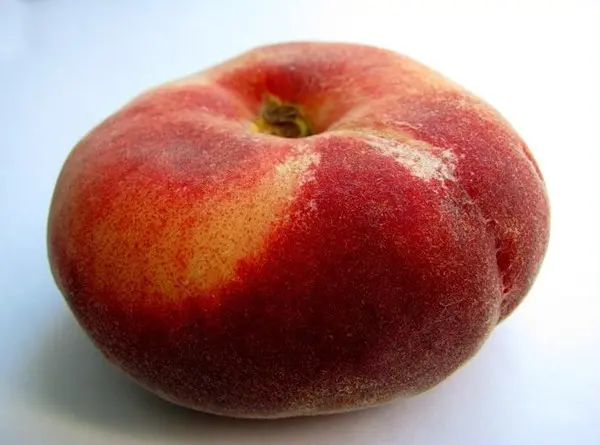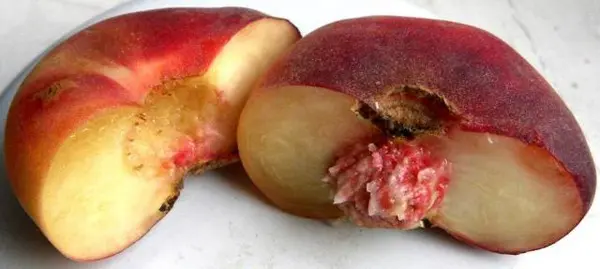Contents
Recently, many amateur gardeners are interested in fig peach, which has a very delicate and pleasant taste, as well as high winter hardiness. The article will introduce you to this fig-like species – what is needed for its cultivation and which varieties are most popular.
Hybrid description
In fact, this is not a hybrid at all, as many people think, and figs have nothing to do with this type. In fact, according to breeders, it is not possible to cross figs with peach. Fig peach (pictured) is one of the types of ordinary peach.

It looks like a fig and has a characteristic flattened shape, the fluff on its skin is much shorter than on ordinary varieties. An important advantage is that this species has a very small bone, its weight is not more than 4 g. Its fruits are very fragrant and tasty, large (the diameter of the “saucer” reaches 7 cm, and its height is 4 cm), weighing 80-120 g The fig peach differs from the usual color of the pulp – it is mostly white in it (in some varieties it is yellow). It also has an excellent taste, evenly distributed throughout the fruit, which is not typical of ordinary species. They are characterized by a pronounced taste only under the very skin and the closer to the bone, the taste will be lost and “dissolved”.
Due to the flattened shape, it is much easier to transport. In general, the fig peach has most of the characteristics that are so lacking in the usual look.
A fig peach in European countries is often called a “donut” because of the stone – when it is removed, a neat hole remains exactly in the middle of the fruit.
A useful property is that most varieties of this species are late and the fruit ripening period is mid-August. Together with high frost resistance (both buds and branches), which significantly exceeds the frost resistance of ordinary species, it tolerates spring frosts better and gives large yields in years with difficult winters.
But there is also a minus: the species is very poorly adapted to the fight against gray rot, although it copes well with other diseases.
Cultivation
Caring for this species is practically no different from the agricultural technology of conventional varieties. When buying a seedling, it is advisable to check a few points:
- check with the seller about adaptation to the climate of the region where the tree will grow;
- the root system should be healthy, and if you pinch off the bark, there should be a green layer under it (brown color is a sign that the seedling is sick and should not be taken);
- the place of vaccination should be clean and even: without juice and sagging;
- the best survival rate was noted in annual seedlings, so it is necessary to clarify the age of the tree.
Landing
All peach trees love plenty of sunlight, so you should plant a seedling on the south side of the garden in a place that is not blown by the winds. Avoid planting in swampy or damp places, as well as in lowlands.
If you plant in a garden where there are mature trees, then try to ensure that the seedling is not in the shade of larger neighbors – in such conditions, the wood of a young plant does not have time to mature over the summer, which leads to inhibition of the laying of color buds.
Do not plant a fig peach in a garden plot where strawberries, solanaceous crops, melons or alfalfa grew before – you have to wait 3-4 years, otherwise the risk of the tree becoming verticillium is high.
It is worth paying attention to the depth of groundwater – it is desirable that they pass no deeper than 3 meters from the ground.
It is worth noting one interesting pattern – if grapes grow in your region, then peach ones will also feel good here.
Fig peach can be planted in a permanent place in early spring or, if you did not have time to carry out the procedure, favorable conditions for planting are formed in early autumn.
When planting, the land should be fertilized with mineral and organic fertilizers. Here you need to look at the fertility of the soil and the time of planting: if the earth is poor in useful minerals, then superphosphate, potassium, ash, manure or humus are added. If chernozem – limited to mineral additives and ash. In autumn, fertilizers are not applied at all, but only humus is added to the bottom of the planting pit.
Having planted a seedling, they trample down the ground and fill it with 2-3 buckets of water, and then mulch the soil with manure to a depth of 10 cm.
Due to the fact that the seedling is at high risk of infection with gray rot, immediately after planting it is treated with pesticides.
Watering
All peach trees tolerate drought well, but the lack of moisture affects the yield. Therefore, if the summer is hot, it is recommended to pour 2-3 buckets of water under the tree every 2-3 weeks from June to August.
Additional fertilizing
Mineral fertilizers are applied to the trunk circle annually during spring digging. Organic matter (manure, humus) is added to the soil around the tree every 2-3 years. It can be replaced by planting green fertilizers in the near-trunk circle – rapeseed, colza or oil radish.
It is also necessary to constantly carry out preventive spraying from pests and spring thinning of the ovaries, since all peach trees have an increased yield, due to which there is a significant load on the tree branches.
It is advisable to do corrective pruning every spring to form the crown of the tree, as well as remove dry or diseased branches, covering the cuts with garden pitch.
Video “Thinning peach ovaries”
This video will tell you how to properly thin out the ovaries of peach varieties.
Sorts
There are several varieties of fig peach. All of them are united by the appearance of the fruit: flattened, in the shape of a plate. There are varieties “Fig White”, “Fig New”, “Vladimir”, “Sweet Cap”, “Nikitsky Flat”, “Saturn”, “UFO” (3, 4, 5). Consider the description of the most popular and common of them:
- fig peach variety “Nikitsky flat” (pictured) – the most adapted to our climatic conditions. The crown of the tree is spreading, the tree itself is low. Fruits weighing up to 94-100 g, with sweet light cream pulp. Fruits in mid-August.
- “Vladimir” – a medium-sized variety, ripens in early August. Fruit weighing up to 180 g. Color is white with a light red blush. The flesh is very sweet, creamy in color. It has a high yield and is less prone to disease than others;
- Sweet Cap. Tree of medium height. Fruits in mid-August. The fruits are burgundy, up to 140 g. The pulp is white, slightly sour. Begins to bear fruit in 3-4 years.

Fig peach is perhaps the most adapted variety for growing by amateur gardeners due to its winter hardiness, natural immunity from most diseases, and high yield. But, besides this, this type of peach for owners is an additional source of income due to the high market price of the fruit.









